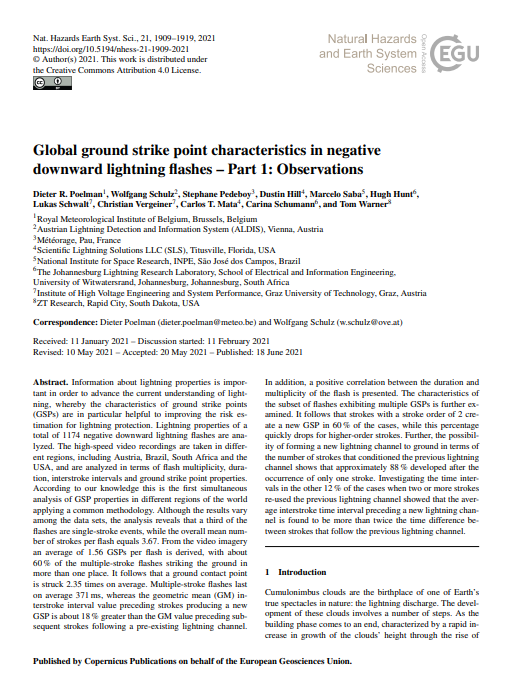PUBBLICAZIONI E NOTE TECNICHE
Global ground strike point characteristics in negative downward lightning flashes
Questo studio è stato pubblicato da Copernicus Publications per conto dell’Unione Europea delle Geoscienze.

Sintesi (in inglese)
Information about lightning properties is important in order to advance the current understanding of lightning, whereby the characteristics of ground strike points (GSPs) are in particular helpful to improving the risk estimation for lightning protection.
Lightning properties of a total of 1174 negative downward lightning flashes are analyzed. The high-speed video recordings are taken in different regions, including Austria, Brazil, South Africa and the USA, and are analyzed in terms of flash multiplicity, duration, interstroke intervals and ground strike point properties.
According to our knowledge this is the first simultaneous analysis of GSP properties in different regions of the world applying a common methodology. Although the results vary among the data sets, the analysis reveals that a third of the flashes are single-stroke events, while the overall mean number of strokes per flash equals 3.67. From the video imagery an average of 1.56 GSPs per flash is derived, with about 60% of the multiple-stroke flashes striking the ground in more than one place. It follows that a ground contact point is struck 2.35 times on average. Multiple-stroke flashes last on average 371 ms, whereas the geometric mean (GM) interstroke interval value preceding strokes producing a new GSP is about 18% greater than the GM value preceding subsequent strokes following a pre-existing lightning channel.
In addition, a positive correlation between the duration and multiplicity of the flash is presented. The characteristics of the subset of flashes exhibiting multiple GSPs is further examined.
It follows that strokes with a stroke order of 2 create a new GSP in 60% of the cases, while this percentage quickly drops for higher-order strokes. Further, the possibility of forming a new lightning channel to ground in terms of the number of strokes that conditioned the previous lightning channel shows that approximately 88% developed after the occurrence of only one stroke. Investigating the time intervals in the other 12% of the cases when two or more strokes re-used the previous lightning channel showed that the average interstroke time interval preceding a new lightning channel is found to be more than twice the time difference between strokes that follow the previous lightning channel.
